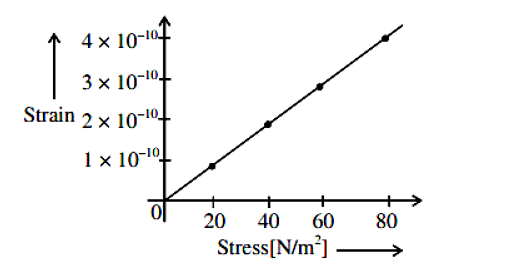Young's modulus of a perfect rigid body is
- Zero
- Unity
- Infinity
- Between zero and unity
The Correct Option is C
Approach Solution - 1
Young's modulus is a measure of the stiffness of a material and is defined as the ratio of stress to strain. For a perfectly rigid body, there is no deformation under applied stress, implying that the strain is zero. Since Young's modulus is the ratio of stress to strain, for a perfectly rigid body, it would be infinite, as the strain approaches zero.
So, the correct answer is (C): Infinity
Approach Solution -2
Young's modulus \( Y \) is defined as the ratio of stress to strain in a material. Mathematically: \[ Y = \frac{\text{Stress}}{\text{Strain}} = \frac{F/A}{\Delta L / L} \] where:
\( F \) is the force applied,
\( A \) is the cross-sectional area,
\( \Delta L \) is the change in length,
\( L \) is the original length.
For a perfect rigid body, no deformation occurs regardless of the applied force, meaning the strain is zero. Since strain is zero, and Young's modulus involves dividing by strain, this results in an infinite value for Young's modulus.
Thus, the Young's modulus for a perfect rigid body is infinite.
Top Questions on elastic moduli
- The slope of the stress-strain curve in the elastic deformation region is
- JKCET - 2024
- Physics
- elastic moduli
- The law which states that within elastic limits strain produced is proportional to the stress producing it is known as
- JKCET - 2024
- Physics
- elastic moduli
- A wire of length L and radius r is clamped rigidly at one end. When the other end of the wire is pulled by a force F, its length increases by 5 cm. Another wire of the same material of length 4L and radius 4r is pulled by a force 4F under same conditions. The increase in length of this wire is ___ cm.
- JEE Main - 2022
- Physics
- elastic moduli
The elastic behavior of material for linear stress and linear strain, is shown in the figure. The energy density for a linear strain of 5×10–4 is ____ kJ/m3. Assume that material is elastic up to the linear strain of 5×10–4

- JEE Main - 2022
- Physics
- elastic moduli
- If the length of a wire is made double and radius is halved of its respective values. Then, the Young’s modulus of the material of the wire will :
- JEE Main - 2022
- Physics
- elastic moduli
Questions Asked in KCET exam
- If the number of terms in the binomial expansion of \((2x + 3)^n\) is 22, then the value of \(n\) is:
- KCET - 2025
- Binomial theorem
- A random experiment has five outcomes \(w_1, w_2, w_3, w_4, w_5\). The probabilities of the occurrence of the outcomes \(w_1, w_2, w_4, w_5\) are respectively \( \frac{1}{6}, a, b, \frac{1}{12} \) such that \(12a + 12b - 1 = 0\). Then the probabilities of occurrence of the outcome \(w_3\) is:
- KCET - 2025
- Probability
- If 'a' and 'b' are the order and degree respectively of the differentiable equation \[ \frac{d^2 y}{dx^2} + \left(\frac{dy}{dx}\right)^3 + x^4 = 0, \quad \text{then} \, a - b = \, \_ \_ \]
- KCET - 2025
- Differential equations
- Meera visits only one of the two temples A and B in her locality. Probability that she visits temple A is \( \frac{2}{5} \). If she visits temple A, the probability that she meets her friend is \( \frac{1}{3} \). The probability that she meets her friend, whereas it is \( \frac{2}{7} \) if she visits temple B. Meera met her friend at one of the two temples. The probability that she met her friend at temple B is:
- KCET - 2025
- Probability
In a practical examination, the following pedigree chart was given as a spotter for identification. The students identify the given pedigree chart as

- KCET - 2025
- Genetics